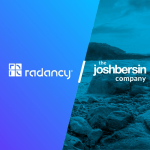Efficient candidate tracking is essential for hiring teams looking to stay competitive in the market. However, many organizations still rely on outdated methods like spreadsheets, email chains or a legacy Applicant Tracking System (ATS) that weren’t built for speed, scale or personalization. These traditional approaches often create bottlenecks, frustrate hiring teams and leave candidates in the dark.
As candidate expectations rise and talent acquisition becomes more complex, traditional tracking methods are no longer sufficient for recruiters to be successful. Instead, AI-powered talent acquisition platforms designed to streamline workflows and deliver better experiences have become essential for efficiency and relevancy in a rapidly evolving market.
The Problem with Traditional Candidate Tracking
Legacy tracking systems and manual processes may have worked in the past, but they’re increasingly misaligned with modern hiring needs. Hiring teams are expected to manage high volumes of applicants, coordinate across distributed teams and deliver a seamless experience to candidates.
With traditional candidate tracking, recruiters have to manage:
- Lack of real-time visibility: Hiring managers and recruiters often struggle to get a clear picture of where candidates are in the pipeline, leading to delays and missed opportunities.
- Manual errors and inefficiencies: Spreadsheet-based tracking is prone to mistakes, version control issues and time-consuming updates.
- Poor candidate experience: Without timely communication or status updates, candidates can feel neglected, which can hurt employer branding.
- Limited scalability: As hiring volumes grow, traditional systems buckle under the pressure, making it harder to manage multiple roles and candidates simultaneously.
Traditional tracking tools weren’t built for the demands of recruiting today. Though they were once effective, now they can create friction and hinder an organization’s ability to compete for top talent. These limitations have prompted a shift toward smarter, more adaptive solutions.
The Rise of AI in Talent Acquisition
AI-powered talent acquisition platforms are transforming how organizations attract, engage and hire candidates. Instead of relying on manual processes, these platforms automate key tasks, surface insights and help recruiters make faster, more informed decisions. AI platforms analyze data to match candidates with roles more accurately, streamline communication and reduce time to hire.
What sets AI apart is its ability to learn and adapt. It can identify patterns in candidate behavior, predict outcomes and optimize in real time. This means hiring teams spend less time on tedious tasks and more time building relationships with top talent.
AI can also enhance collaboration across teams. With centralized data and shared dashboards that provide insights into candidate progress, recruiters and hiring managers can work together more effectively, reducing miscommunication and speeding up decision making. The result is a more efficient, personalized and scalable hiring process that meets candidate and employer expectations.
Looking for more on how AI is impacting hiring? Check out our white paper on next-gen talent acquisition.
How AI Improves Candidate Tracking
AI-powered tracking systems offer a level of visibility and control that traditional methods simply can’t match. Recruiters can see exactly where each candidate is in the process, from initial application to final offer, without having to sift through disconnected tools. Automated updates ensure that candidates are being communicated with consistently, helping to build trust and engagement throughout the journey.
These platforms also provide valuable data that helps teams understand what’s working and what isn’t. Whether it’s identifying bottlenecks in the interview process or evaluating the effectiveness of sourcing channels, AI delivers actionable insights that drive better hiring outcomes. This way, recruiters can refine their strategies, allocate resources more effectively and continuously improve performance.
Additionally, when everything is unified and integrated, hiring teams can manage job postings, candidate profiles and interview schedules from a single dashboard. This centralization reduces complexity and enables faster decision making, especially when hiring at scale.
How Radancy Can Help with Candidate Tracking
The Radancy Talent Acquisition Cloud is built to solve the challenges that traditional candidate tracking systems create. By combining automation, AI and real-time insights, Radancy empowers talent teams to accelerate results, simplify hiring and reimagine candidate experiences.
Our platform, powered by Agentic AI, centralizes candidate data, streamlines communication and provides the tools you need to make smarter hiring decisions. Whether you’re hiring for one role or scaling across departments, Radancy helps you stay organized, informed and ahead of the curve.
Hiring teams gain the visibility, efficiency and flexibility they need to compete in today’s talent market. Because our platform is designed with both recruiters and candidates in mind, it delivers a seamless experience that strengthens your employer brand and drives better outcomes.
To stay up to date with the latest trends in talent acquisition and hiring technology, subscribe to our newsletter for expert insights, upcoming events, webinars and more. See how Radancy can help transform your talent acquisition strategy.
- HR ROI Decoded: How to Measure the Real Impact of Your Recruitment Strategy - December 11, 2025
- Fosway Viewpoint Paper Recap: How Agentic AI Is Reshaping Talent Acquisition - November 11, 2025
- How AI Talent Acquisition Platforms Are Transforming Candidate Tracking - October 23, 2025
- The Josh Bersin Company Report Recap: The Talent Acquisition Revolution - October 21, 2025
- Optimizing Hiring: The Power of AI Recruiting Tools and Human Insight - October 9, 2025
- Talent Acquisition vs. Recruitment: What’s the Real Difference? - September 15, 2025
- Beyond AI Hype: Building Talent Intelligence Architecture - September 11, 2025
- AI Talent Prediction: How You Can Stay Ahead of Hiring Gaps - August 28, 2025
- What is an Employee Value Proposition? A Talent Strategy Essential - July 24, 2025
- How to Master Human Resource Forecasting in Uncertain Times - July 10, 2025









